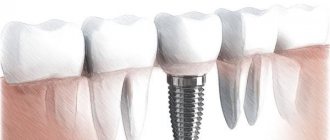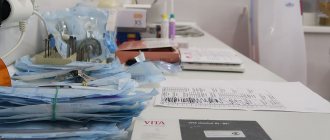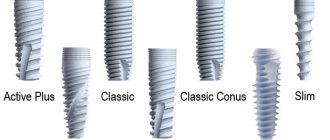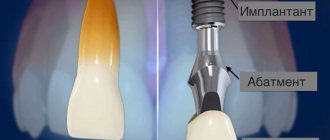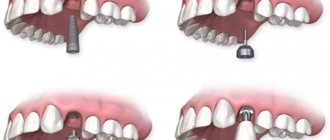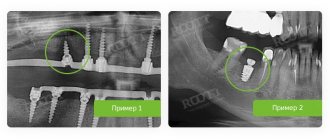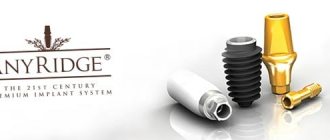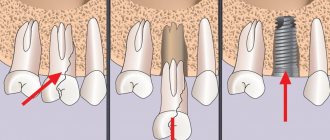Indications for implant removal
- Rejection of the structure mainly develops within six months after implantation.
- Peri-implantitis or perimucositis - the first is accompanied by a loss of jaw bone against the background of inflammation of the soft tissues, the second occurs without loss of tissue volume.
- Excessive load on the implant - occurs due to violation of the installation protocol.
- Incorrect position or defective implant is extremely rare.
- End of service life - for models with limited serviceability.
In our clinic, implant installation is carried out strictly in accordance with surgical protocols, using the most reliable systems in the world, Nobel Biocare (USA), with a lifetime warranty from the manufacturer and almost zero risk of rejection. If an unpleasant situation does arise, we guarantee free dismantling of the structure.
What determines the service life of a dental implant?
The service life of the implant assumes the warranty specified by the manufacturer on the packaging. Companies that produce premium dental structures, for example, Nobel Biocare, Astra Tech, XIVE Friadent, Straumann, give them a lifetime guarantee . They will not have to be changed unless unforeseen circumstances arise.
Other companies set a period of 20-25 years . After this time, the worn-out implant, if defective, must be removed. Although, with proper care, even such options last longer than the manufacturer indicated.
The service life of titanium roots is affected by:
- qualified work of an implantologist;
- professionalism of the orthopedist in the manufacture of the prosthesis;
- high quality construction;
- proper oral hygiene;
- absence of serious diseases.
The presence of these conditions favors the long-term operation of installed dental systems.
How are dental implants removed?
After the doctor, based on X-ray data, decides to remove the dental implant, a planned operation is scheduled. Removal of dental implants occurs in this way:
- Anesthesia is performed.
- The temporary or permanent crown is removed.
- The gum is incised to provide access to the artificial root.
- The implant is removed.
- Sutures are placed (if re-implantation is planned, bone material is added before suturing).
Symptoms
It is necessary to urgently contact dentistry if dental implantation has been performed, but a week after the intervention you are concerned about:
- Severe bleeding, hyperemia and pain in the gums on days 4-6 after the installation of an artificial tooth.
- Burning sensation and discomfort in the area where the implant is installed that does not disappear after taking anesthetics signal pathologies that may cause removal of the pin.
- Formation of exudate in the tissues around the implant.
- Significant swelling.
When dental implantation was carried out years ago, not very well (perhaps the level of diagnosis was low), and the pin became mobile, pain appeared when biting, you need to go to the doctor. When applying in the postoperative period, conservative treatment is possible, but sometimes it is necessary to take urgent measures.
Dental implant removal cost
The cost of removing a titanium rod is equivalent to removing a complex tooth. However, a number of factors are taken into account that can increase the final amount. This is bone grafting, plastic surgery of soft gum tissue. Additional procedures are paid separately.
If the implantation was carried out in a clinic and the removal is performed in the same clinic, the procedure is free under warranty . If the patient came from another clinic, he needs to pay for the service. The price will depend on the clinical picture.
Responsibilities of the surgeon
To avoid forced removal of implants, the surgeon must fulfill the following requirements:
- carefully prepare the oral cavity for surgery;
- diagnose all diseases that are included in the list of contraindications for implantation;
- if necessary, perform plastic surgery of the jawbone;
- impeccable adherence to the operation protocol;
- ensure absolute sterility of the oral cavity and surgical instruments;
- provide the patient with a complete list of recommendations for oral care during the rehabilitation period.
Why does the implant not take root?
Physiological rejection
Occurs as a result of the patient’s body’s rejection of implants for the following reasons:
- allergic reaction to components of the dental system material;
- weakened immune system;
- chronic diseases in the acute stage;
- trauma to the jaw bone at the site of rod insertion;
- installation of an implant without taking into account the individual characteristics of the patient’s dental apparatus.
Doctor's mistakes
In clinics that value their reputation, such situations rarely happen:
- unsatisfactory diagnosis and sanitation of the oral cavity at the preparatory stage for implantation;
- neglect of the osteoplasty procedure for bone tissue atrophy;
- incorrect selection of the implant model, location in the jaw, unreliable fixation;
- violation of sterility;
- premature load on the structure, unacceptable in a particular situation;
- use of rods of questionable quality.
Patient errors
We make sure to give recommendations to the patient after implantation. If he was irresponsible in their implementation, the implant may be rejected due to:
- getting infections into the mouth through unwashed hands;
- non-compliance with the rules of daily oral hygiene;
- failure to follow postoperative recommendations for taking antibiotics and other drugs;
- smoking, drinking alcohol immediately after implantation of a titanium rod;
- increased physical activity;
- thermal procedures (bath, sauna, hot bath, overheating under the sun);
- hypothermia;
- neglect of doctor visits for examinations and preventive office procedures.
Reasons for rejection
If you look at any online dental directory, you will see that modern implants take root in more than 98% of cases - such data inspires optimism. However, in reality, the final result of treatment is also influenced by how competently and technically correctly the installation was carried out, as well as how the further rehabilitation plan was drawn up and followed. That is why some of the most common reasons for implant rejection are medical errors, as well as the negligence of the patients themselves in relation to their health.
| The doctor's fault | Patient's guilt | Other factors |
| 1. Technical errors when installing the implant. Incorrect positioning, rough installation, which leads to damage to nerves, arteries or the maxillary sinus | 1. Failure to comply with doctor’s instructions before and after surgery. | 1. Exacerbation of chronic diseases and a sharp decrease in immunity during osseointegration. |
| 2. Working in unsanitary conditions. | 2. Inadequate oral hygiene and abuse of bad habits (cigarettes, alcohol). | 2. Poor quality implant (defective from the manufacturer). |
| 3. Errors during prosthetics, when an incorrectly installed prosthesis contributes to implant mobility. | 3. Deliberate concealment of diseases that are included in the list of contraindications for implantation. | 3. Mechanical injuries causing damage to the jaw. |
Rejection symptoms
- Bleeding, redness of the gums;
- swelling;
- pain;
- increased body temperature;
- mobility of the artificial root;
- detachment of soft gum tissue by more than 1 mm;
- headache;
- difficulty chewing food;
- bad breath;
- weakness;
- the appearance of fistula tracts in the subgingival part;
- violation of the symmetry of the oval of the face.
Bleeding, swelling of the gums, pain and fever are normal in the first week after implantation. If they persist and other unpleasant signs are added, you should urgently consult the doctor who performed the operation.
What should the patient know?
Every person planning dental implants should know the following.
- Dental implantation is not subject to compulsory health insurance, as it is a purely commercial service.
- A broken prosthesis can be replaced free of charge only in the clinic in which it was installed and provided that the fracture was not the fault of the patient.
- The cost of treating complications that arise can be many times greater than the cost of the operation itself, and therefore you must strictly follow all the doctor’s recommendations.
- The choice of clinic lies entirely with the patient, and this choice must be taken extremely responsibly. You should only contact places that provide a written guarantee of the high quality of implantation.
How to avoid complications
It is possible to prevent the removal of a dental implant. Negative consequences are minimized when:
- a responsible approach to the issue of choosing a clinic - it is important to find out about certification for the right to conduct such operations, the qualifications of doctors, and familiarize yourself with the terms of the contract;
- maintaining sterility and hygiene during the rehabilitation period after implantation;
- quitting smoking and alcohol in the first 7-10 days;
- minimizing physical activity;
- excluding solid foods and hot foods from the diet;
- refusal of thermal procedures;
- Regular visits to the clinic in accordance with the drawn up treatment plan.
Implantation is a serious surgical procedure, and during the recovery phase it is important to follow recommendations regarding nutrition, hygiene, and medication.
Several examples of unsuccessful implantation
Let's talk about two cases that took place in our practice, which resulted in the removal of implants.
The man did not inform the surgeon that he had undergone a cycle of chemotherapy sessions due to the presence of an oncological tumor in the jaw bone. As a result, the implant was installed on the affected bone area. Of course, there is also the fault of the surgeon, who should have noticed changes in the diseased area of the bone. Of course, the implantation did not occur due to a decrease in the regenerative function of the bone. Not only did the implant have to be removed, but the patient had to be treated for another six months for the consequences of the intervention in the tumor. One of our patients had a briquette system installed, but it was not possible to cover the entire dentition. She was offered implantation of one tooth with the build-up of dental tissue on the jawbone. Alas, the implantation of the titanium root did not occur due to the pressure on it from neighboring teeth. As a result, the implant had to be removed.
In what cases is surgery required?
The main indication for implant removal is rejection of the material by the body. In most cases, this process is observed within 3-6 months after implantation. In rare cases, the implant may fail a year after installation.
The main reasons that can trigger the rejection process include:
- medical error during the implantation process, including incorrect installation, after which an uneven load on the dentition occurs
- improper oral care
- some diseases affecting oral tissue or bone dystrophy
- low quality materials
The need to remove implants also arises after prolonged use, since these products have a limited service life.
When should an implant be removed?
We extremely rarely encounter the need to remove a dental implant. However, from time to time, patients turn to us for help who had implants installed in other clinics and encountered problems immediately in the postoperative period, or during prosthetics on already “established” implants. There are two possible reasons for removing implants:
- peri-implantitis (inflammation and loss of bone tissue in the implant area);
- the inability, for one reason or another, to install high-quality crowns (that is, to carry out rational prosthetics) on already “established” implants.
Peri-implantitis can be divided into two types:
- Beginning in the early period, immediately after installation of the implant and before its “opening”, that is, installation of the gum former, and the beginning of permanent prosthetics;
- In a more distant time, for example, a year or even later after the manufacture of permanent crowns.
1. The first type of peri-implantitis is accompanied by inflammation, fistulas, pain and other similar symptoms. In the short term, often immediately after implantation, this is often called “rejection” of the implant, or they say that the implant “did not take root.”
In the first months after installation, the tissue around the implant goes through the stage of forming a rigid bone “capsule” surrounding the implant. The capsule creates conditions for adequate absorption of chewing load by the implant and surrounding tissues. This process is called osseointegration of the implant.
A successfully osseointegrated implant is firmly and immovably positioned in the jawbone and cannot itself cause any discomfort. If, after installation, infection occurs or excessive load on the implant and osseointegration does not occur, then micromobility occurs and symptoms of peri-implantitis begin to appear. In such cases, patients may be concerned about fistula formation. After removal of the sutures, swelling and redness of the soft tissues persist or appear new, even several weeks after surgery. Unpleasant odors and other negative sensations occur in the area of the installed implant.
If a gum former or temporary crown is installed simultaneously with an implant, then peri-implantitis causes pain when pressing on the former or crown, and the appearance of mobility, which is a direct indication for removal of the implant.
2. Peri-implantitis in the long term usually develops more slowly. There are no symptoms in the first stages, or they do not bother the patient. Subsequently, sometimes after quite significant periods of time, the bone and gums around the implant become inflamed, pain, an unpleasant odor, and purulent discharge appear. In such cases, the implants are either removed or attempts are made to save them by removing the source of inflammation and, if possible, replacing part of the lost bone. The main reasons for such situations are incorrectly manufactured prostheses (crowns) or overloading of implants. Doctors often install narrow and short implants to avoid bone grafting - bone augmentation. Or they save on their quantity, prosthetizing the entire jaw with only 4 implants, which, naturally, leads to significant overload. Thin and short implants cannot withstand the chewing load and the bone around them begins to dissolve, resulting in removal.
Inability to carry out rational prosthetics
The main task of the implant surgeon is to install the implant in exact accordance with the location (depth and axis) of the future crown.
Megastom clinics always carry out 3D planning of implantation surgery. All subsequent work is carried out in accordance with the planned position of the future crown on the implant, that is, with the required end result. In addition, treatment is carried out by a team of doctors who constantly coordinate their actions and, if necessary, consult with the chief physician of the clinic.
Unfortunately, many dentists still do not carry out adequate implant planning and place implants “where the bone is” rather than where they need to be. In this case, the implants successfully take root, but are installed in the wrong position. How to make a crown in this case? Sometimes this can be compensated for by the special capabilities of orthopedic structures. But often the only way to make a crown correctly is to remove the old implant and install a new one in the correct position.
What conclusion can be drawn to avoid implant removal after implantation surgery? Choose a dental clinic with many years of successful experience in dental implantation, qualified doctors and high-quality implants.
At Megastom clinics, the basis for a successful implantation result is:
- competent 3D computer planning,
- strict adherence to technology,
- reliable implantation system (Germany),
- application of a 3D surgical guide,
- an integrated approach involving all specialists of the clinic,
- functionality and aesthetics,
- careful care of crowns,
- observation to maintain the obtained result.


